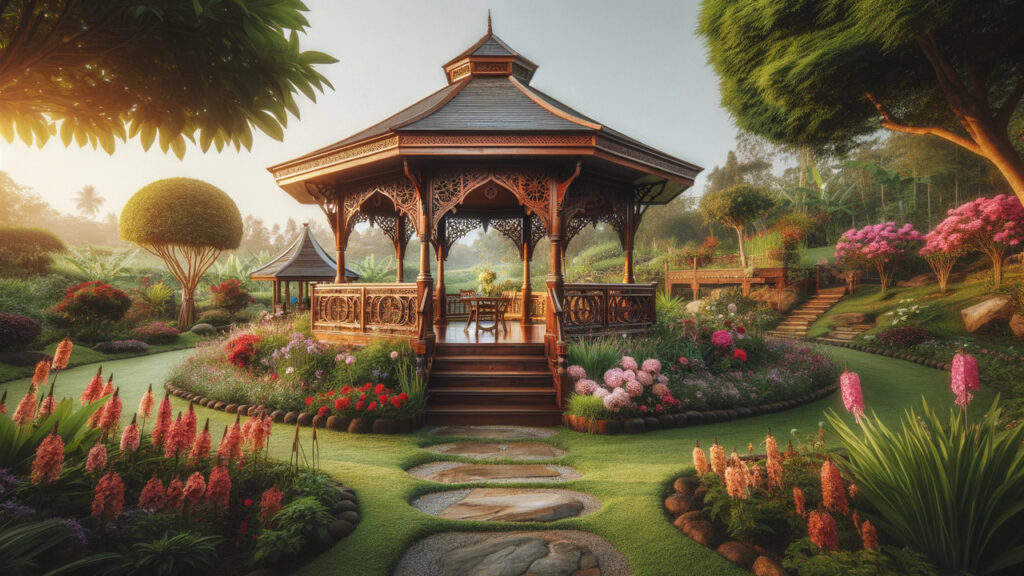Introduction to Gazebos
A gazebo is a freestanding, open-sided structure with a solid roof, often used to provide shade and shelter in outdoor spaces. These charming constructions can be made from various materials, including wood, metal, and vinyl, and can come in different styles, from classic to contemporary. Gazebos serve multiple purposes, from offering a tranquil retreat in a garden to being a centerpiece for social gatherings.
Historical Background of Gazebos
Gazebos have a rich history dating back to ancient civilizations. In ancient Egypt, gardens were built with small pavilions to provide shade from the sun. In Persia, garden pavilions called “talar” were prominent features. The modern concept of the gazebo evolved during the Renaissance in Europe, where they were used in public gardens and private estates to offer scenic views and serve as a place for relaxation.
Types of Gazebos
- Traditional Gazebos are often octagonal or hexagonal, featuring intricate woodwork and a pitched roof. Traditional gazebos evoke a sense of classic charm and are commonly made from wood or vinyl.
- Modern Gazebos: Modern designs focus on sleek lines and minimalistic aesthetics. Materials such as metal, glass, and composites are frequently used. These gazebos often include contemporary features like built-in seating and lighting.
- Pop-up Gazebos: Ideal for temporary use, pop-up gazebos are portable and easy to assemble. They are perfect for events like picnics, outdoor markets, and camping.
- Pergolas and Pavilions: While not strictly gazebos, pergolas and pavilions share similarities. Pergolas typically have open-lattice roofs, whereas pavilions have a solid roof and are often larger structures.
Benefits of Owning a Gazebo
Extended Living Space: Gazebos create an additional living area outdoors. They can serve as an outdoor dining room, a lounge, or even a play area for children.
Aesthetic Appeal: A well-designed gazebo can enhance the visual appeal of your garden or backyard, serving as a focal point that complements the landscaping.
Protection from Elements: Gazebos provide shelter from the sun, rain, and wind, allowing you to enjoy the outdoors comfortably in various weather conditions.
Increased Property Value: Installing a gazebo can boost the value of your property by adding an attractive feature that potential buyers may find desirable.
Designing Your Perfect Gazebo
Material Selection: The choice of materials impacts the gazebo’s durability and appearance. Wood offers a classic look but requires regular maintenance. Metal and vinyl are low-maintenance options and are available in various styles.
Size and Shape: The size and shape of the gazebo should match the available space and intended use. A large, octagonal gazebo is perfect for hosting parties, while a small, square gazebo can create a cozy reading nook.
Location: Placement is crucial. Consider positioning the gazebo to maximize views, provide shade, and integrate seamlessly with the garden’s layout.
Customization Options: Gazebos can be customized with features such as built-in seating, lighting, curtains, and screens to enhance comfort and functionality.
Maintenance Tips
Regular maintenance ensures the longevity and beauty of your gazebo. Here are some tips:
- Cleaning: Regularly clean the gazebo to remove dirt, mold, and mildew. Use a mild detergent and a soft brush.
- Staining and Sealing: Wooden gazebos should be stained and sealed every few years to protect against the elements.
- Inspecting for Damage: Periodically check for signs of wear and tear, such as loose screws, damaged wood, or rust on metal parts, and repair as necessary.
- Winterizing: If you live in an area with harsh winters, consider winterizing your gazebo by adding covers or screens to protect it from snow and ice.
Creative Uses for Gazebos
Outdoor Dining: Transform your gazebo into a charming outdoor dining area. Add a table, chairs, and decorative lighting to create an inviting meal space.
Garden Retreat: Add comfortable seating, cushions, and potted plants to create a peaceful garden retreat. This can be an ideal spot for reading, meditation, or simply enjoying nature.
Event Space: Gazebos are perfect for hosting events such as weddings, parties, and family gatherings. Decorate the space with flowers, fairy lights, and other festive elements to match the occasion.
Home Office: With the rise of remote work, a gazebo can serve as an outdoor home office. Enjoy the fresh air and natural light while staying productive.
Conclusion
Gazebos are a versatile and beautiful addition to any outdoor space. Whether you opt for a traditional wooden design, a sleek modern structure, or a portable pop-up gazebo, these structures offer numerous benefits. A gazebo is a worthwhile investment, from enhancing your garden’s aesthetic appeal to providing a functional outdoor living area. By carefully selecting the suitable materials, size, and location and maintaining your gazebo correctly, you can enjoy this charming outdoor sanctuary for years to come.
FAQs About Gazebos
Q: What is the best material for a gazebo?
A: The best material depends on your preferences and climate. Wood offers a traditional look but requires maintenance. Metal and vinyl are durable and low-maintenance options.
Q: Can I install a gazebo on a deck?
A: Yes, gazebos can be installed on decks. Ensure the deck is structurally sound and can support the gazebo’s weight.
Q: Do gazebos require permits?
A: Permit requirements vary by location. Check with your local building authority to determine if a permit is needed for your gazebo.
Q: How do I maintain a wooden gazebo?
A: Regular cleaning, staining, and sealing are essential for maintaining a wooden gazebo. Inspect for damage and make repairs as needed.
Q: Can gazebos be used year-round?
A: With proper maintenance and winterizing, gazebos can be used year-round. Adding screens or covers can provide additional protection during colder months.
Also Read: Rightmove Plus: Enhancing Your Property Search Experience
